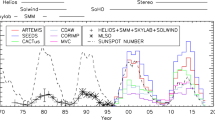Abstract
We investigated some properties of coronal mass ejections (CMEs), such as speed, acceleration, polar angle, angular width, and mass, using data acquired by the Large Angle Spectrometric Coronagraph (LASCO) onboard the Solar and Heliospheric Observatory (SOHO) from 31 July 1997 to 31 March 2014, i.e. during the Solar Cycles 23 and 24. We used two CME catalogs: one provided by the Coordinated Data Analysis Workshops (CDAW) Data Center and one obtained by the Computer Aided CME Tracking software (CACTus) detection algorithm. For each dataset, we found that the number of CMEs observed during the peak of Cycle 24 was higher than or comparable to the number during Cycle 23, although the photospheric activity during Cycle 24 was weaker than during Cycle 23. Using the CMEs detected by CACTus, we noted that the number of events \([N]\) is of the same order of magnitude during the peaks of the two cycles, but the peak of the CME distribution during Cycle 24 is more extended in time (\(N > 1500\) during 2012 and 2013). We ascribe the discrepancy between the CDAW and CACTus results to the observer bias for CME definition in the CDAW catalog. We also used a dataset containing 19,811 flares of C-, M-, and X-class observed by the Geostationary Operational Environmental Satellite (GOES) during the same period. Using both datasets, we studied the relationship between the mass ejected by the CMEs and the flux emitted during the corresponding flares: we found 11,441 flares that were temporally correlated with CMEs for CDAW and 9120 for CACTus. Moreover, we found a log–linear relationship between the flux of the flares integrated from the start to end in the 0.1 – 0.8 nm range and the CME mass. We also found some differences in the mean CMEs velocity and acceleration between the events associated with flares and those that were not.
















Similar content being viewed by others
References
Aarnio, A.N., Stassun, K.G., Hughes, W.J., McGregor, S.L.: 2011, Solar Phys. 268, 195. ADS . DOI .
Brueckner, G.E., Howard, R.A., Koomen, M.J., Korendyke, C.M., Michels, D.J., Moses, J.D., Socker, D.G., Dere, K.P., Lamy, P.L., Llebaria, A., Bout, M.V., Schwenn, R., Simnett, G.M., Bedford, D.K., Eyles, C.J.: 1995, Solar Phys. 162, 357. ADS . DOI .
Chen, A.Q., Chen, P.F., Fang, C.: 2006, Astron. Astrophys. 456, 1153. ADS . DOI .
Cremades, H., St. Cyr, O.C.: 2007, Adv. Space Res. 40, 1042. ADS . DOI .
Delaboudinière, J.-P., Artzner, G.E., Brunaud, J., Gabriel, A.H., Hochedez, J.F., Millier, F., Song, X.Y., Au, B., Dere, K.P., Howard, R.A., Kreplin, R., Michels, D.J., Moses, J.D., Defise, J.M., Jamar, C., Rochus, P., Chauvineau, J.P., Marioge, J.P., Catura, R.C., Lemen, J.R., Shing, L., Stern, R.A., Gurman, J.B., Neupert, W.M., Maucherat, A., Clette, F., Cugnon, P., van Dessel, E.L.: 1995, Solar Phys. 162, 291. ADS . DOI .
Gilbert, H.R., Holzer, T.E., Burkepile, J.T., Hundhausen, A.J.: 2000, Astrophys. J. 537, 503. ADS . DOI .
Gopalswamy, N., Makela, P., Akiyama, S., Yashiro, S., Thakur, N.: 2015a, Sun Geosph. 10, 111. ar**v . ADS .
Gopalswamy, N., **e, H., Akiyama, S., Mäkelä, P., Yashiro, S., Michalek, G.: 2015b, Astrophys. J. Lett. 804, L23. ADS . DOI .
Gosling, J.T., Hildner, E., MacQueen, R.M., Munro, R.H., Poland, A.I., Ross, C.L.: 1976, Solar Phys. 48, 389. ADS . DOI .
Howard, M.: 1974, Spaceflight 16, 383. ADS .
Hundhausen, A.J.: 1993, J. Geophys. Res. 98, 13177. ADS . DOI .
Ivanov, E.V., Obridko, V.N.: 2001, Solar Phys. 198, 179. ADS . DOI .
Lin, J., Forbes, T.G.: 2000, J. Geophys. Res. 105, 2375. ADS . DOI .
Ludwig, G., Johnson, D.: 1981, Adv. Space Res. 1, 23. ADS . DOI .
MacQueen, R.M., Fisher, R.R.: 1983, Solar Phys. 89, 89. ADS . DOI .
Mittal, N., Narain, U.: 2009, New Astron. 14, 341. ADS . DOI .
Mittal, N., Sharma, J., Tomar, V., Narain, U.: 2009, Planet. Space Sci. 57, 53. ADS . DOI .
Moon, Y.J., Choe, G.S., Wang, H., Park, Y.D., Cheng, C.Z.: 2003, J. Korean Astron. Soc. 36, 61. ADS . DOI .
Padmanabhan, J., Bisoi, S.K., Ananthakrishnan, S., Tokumaru, M., Fujiki, K., Jose, L., Sridharan, R.: 2015, J. Geophys. Res. 120, 5306. ADS . DOI .
Phillips, K.: 1990, Astron. Now 4, 28. ADS .
Qiu, J., Yurchyshyn, V.B.: 2005, Astrophys. J. 634, L121. ADS . DOI .
Robbrecht, E., Berghmans, D., Van der Linden, R.A.M.: 2009, Astrophys. J. 691, 1222. ADS . DOI .
St. Cyr, O.C., Webb, D.F.: 1991, Solar Phys. 136, 379. ADS . DOI .
St. Cyr, O.C., Burkepile, J.T., Hundhausen, A.J., Lecinski, A.R.: 1999, J. Geophys. Res. 104, 12493. ADS . DOI .
Subramanian, P., Dere, K.P.: 2001, Astrophys. J. 561, 372. ADS . DOI .
Tripathy, S.C., Jain, K., Hill, F.: 2015, Astrophys. J. 812, 20. ADS . DOI .
Webb, D.F., Howard, T.A.: 2012, Living Rev. Solar Phys. 9, 3. DOI .
Yashiro, S., Michalek, G., Gopalswamy, N.: 2008, Ann. Geophys. 26, 3103. ADS . DOI .
Youssef, M.: 2012, NRIAG J. Astron. Geophys. 1, 172. ADS . DOI .
Zhang, J., Dere, K.P., Howard, R.A., Kundu, M.R., White, S.M.: 2001, Astrophys. J. 559, 452. ADS . DOI .
Zhou, G., Wang, J., Cao, Z.: 2003, Astron. Astrophys. 397, 1057. ADS . DOI .
Zolotova, N.V., Ponyavin, D.I.: 2014, J. Geophys. Res. 119, 3281. ADS . DOI .
Acknowledgments
The authors wish to thank the anonymous referee for their useful suggestions that allowed us to improve the article. This research work has received funding from the European Commission’s Seventh Framework Programme under the Grant Agreements no. 606862 (F-Chroma project) and no. 312495 (SOLARNET project). This research is also supported by the ITA MIUR-PRIN grant on “The active sun and its effects on space and Earth climate” and by Space WEather Italian COmmunity (SWICO) Research Program. We are also grateful to the University of Catania for providing the Grant FIR 2014.
Author information
Authors and Affiliations
Corresponding author
Ethics declarations
Disclosure of Potential Conflicts of Interest
The authors declare that they have no conflicts of interest.
Rights and permissions
About this article
Cite this article
Compagnino, A., Romano, P. & Zuccarello, F. A Statistical Study of CME Properties and of the Correlation Between Flares and CMEs over Solar Cycles 23 and 24. Sol Phys 292, 5 (2017). https://doi.org/10.1007/s11207-016-1029-4
Received:
Accepted:
Published:
DOI: https://doi.org/10.1007/s11207-016-1029-4




